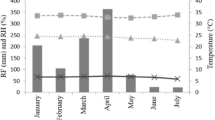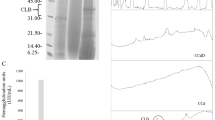Abstract
The aim of this study was to analyse lamb performance as well as conduct an economic evaluation by comparing grazing on weeds at a coffee plantation to grazing on pasturelands (Cynodon plectoslachyus and Pennisetum clandestinum) with and without supplementation. The study was carried out 40 days prior to the coffee harvest. Biological testing was conducted in the municipality of Comapa, Veracruz, using 32 male Pelibuey lambs with an average weight of 22 kg. Animals that consumed supplements and weeds at the coffee plantation had the highest daily weight gain (112.75 g). Analysis of the coffee farm considering the three existing groups (without sheep, with sheep without supplements and with sheep with supplements) presented a positive return rate, with the coffee-sheep-supplement being the best option in terms of economic, agricultural and environmental benefits as a whole, although the return rate was lower. It is concluded that the productive response of sheep obtained with a small amount of supplements (70 g/animal/day) while feeding on weeds was superior to that of animals grazing in pastures of established grasses, even when they received the same dose of supplements. Therefore it is suggested that keeping herds of sheep grazing on weeds in coffee plantations is economically profitable as well as agronomically and environmentally beneficial.
Similar content being viewed by others
Notes
SAGARPA, COFUPRO, UACH, SPC, AMECAFE, & INCA-RURAL. 2011. Plan de innovación en la cafeticultura de México. Fecha de consulta junio 3, 2015, en: http://amecafe.org.mx/downloads/PLAN DE INNOVACION NACIONAL.
AMECAFE A.C. (2012). Innovación: Diagnóstico de la Cafeticultura Nacional. Fecha de consulta: June 3, 2015, en: http://amecafe.org.mx/innovacion-diagnostico-de-la-cafeticultura-nacional/.
in Mexican pesos.
References
Adams VM, Petty AM, Douglas MM, Buckley YM, Ferdinands YM, Ferdinands KB, Okazaki T, Ko DW, Setterfield SA (2015) Distribution, demography and dispersal model of spatial spread of invasive plant populations with limited data. Methods in Ecol Evol 6:782–794. https://doi.org/10.1111/2041-210X.12392
Almodares A, Jafarinia M, Hadi MR (2009) The effects of nitrogen fertilizer on chemical compositions in corn and sweet sorghum. Am-Eurasian J Agric Environ Sci 6:441–446
Alvarez G, Melgarejo L, Castañeda Y (2003) Ganancia de peso, conversión y eficiencia alimentaria en ovinos alimentados con fruto (semilla con vaina) de parota (Enterolobium cyclocarpum) y pollinaza. Vet Mexico 34:39–46
Archimede H, Pellonde P, Despois P, Etienne T, Alexandre G (2008) Growth performances and carcass traits of Ovin Martinik lambs fed various ratios of tropical forage to concentrate under intensive conditions. Small Rumin Res 75:162–170. https://doi.org/10.1016/j.smallrumres.2007.10.001
Arroyo-Guadarrama A, Krishnamurthy L, Leos-Rodriguez J, Lara-Bueno A (2002) Diseño de tecnología silvopastoril asociando ovinos de pelo a plantaciones citrícolas en Veracruz. In: Krishnamurthy L, Uribe-Gómez M (eds) Tecnologías agroforestales para el desarrollo rural sostenible, 1st edn. PNUMA-SEMARNAT, México, pp 281–296
Barahona R, Sánchez S (2005) Limitaciones físicas y químicas de la digestibilidad de pastos tropicales y estrategias para aumentarla. Rev Corpoica 6:69–82
Daniel WW (2002) Bioestadistica: Base para el analisis de las ciencias de la salud, 4th edn. Limusa, México
Franklin-McEvoy J, Belloti WD, Revell DK (2007) Supplementary feeding with grain improves the performance of sheep grazing saltbush (Atriplex nummularia) in autumn. Aust J Exp Agric 47:912–917. https://doi.org/10.1071/EA06149
Gabaldon L, Combellas J (2000) Comportamiento productivo de ovejas pastoreando malezas. Zoot Trop Venezuela 18:277–285
García E (1988) Modificaciones al sistema de clasificación climática de Köppen. Universidad Nacional Autónoma de México, Mexico
Ginane C, Baumont R, Favreau-Peigne A (2011) Perception and hedonic value of basic tastes in domestic ruminants. Physiol Behav 104:666–674. https://doi.org/10.1016/j.physbeh.2011.07.011
Hamill AS, Holt JS, Mallory-Smith CA (2004) Contributions of weed science to weed control and management. Weed Technol 18:1563–1565
Harker KN, O'Donovan JT (2013) Recent weed control, weed management, and integrated weed management. Weed Technol 27:1–11
Hill J, Chapman DF, Cosgrove GP, Parsons AJ (2009) Do ruminants alter their preference for pasture species in response to the synchronization of delivery and release of nutrients? Rangeland Ecol Manag 62:418–427. https://doi.org/10.2111/08-084.1
Kouchi H (2011) Symbiotic nitrogen fixation. In: Ashihara H, Crozier A, Komamine A (eds) Plant metabolism and biotechnology. Wiley, Chichester, pp 67–102
Latimer GW Jr (2012) The official methods of analysis of AOAC International, 19th edn. AOAC International, Gaithersburg
Lisek J (2014) Possibilities and limitations of weed management in fruit crops of the temperate climate zone. J Plant Prot Res 54:318–326. https://doi.org/10.2478/jppr-2014-0048
Mazorra C, Marrero P, Perez L, Méndez R, Fontes D, Donis L, Lavinge C (2013) Composición florística y uso forrajero de arvenses que crecen en áreas citrícolas de Ciego de Ávila, Cuba. Universidad y Ciencia 2:1–21
Melloni R, Belleze G, Pinto AMS, Dias LB, Silve EM, Melloni EG, Pereira A, Nogueira MI, Alcántara EN (2013) Métodos de controle de plantas daninhas e seus impactos na qualidade microbiana de solo sob cafeeiro. R Bras Ci Solo 37:66–75. https://doi.org/10.1590/S0100-06832013000100007
Muniappan R, Reddy GVP, Raman A (eds) (2009) Biological control of weeds in the tropics and sustainability. In: Biological control of tropical weeds using arthropods. Cambridge University Press, Cambridge, pp 1–16
Pathoummalangsy K, Preston TR (2008) Effects of supplementation with rumen fermentable carbohydrate and sources of ‘bypass’ protein on feed intake, digestibility and N retention in growing goats fed a basal diet of foliage of Tithonia diversifolia. Livestock Res Rural Dev Volume 20, supplement. http://www.lrrd.org/lrrd20/supplement/kham20076.htm. Accessed 16 October 2016
Pérez N, Ibrahim M, Villanueva C, Skarpe C, Guerin H (2012) Uso de la diversidad forrajera tropical en combinaciones pareadas de leñosas forrajeras como indicador de preferencia para su inclusión en el diseño de sistemas silvopastoriles en zonas secas. Corpoica Cienc Tecnol Agropecu 13:79–88
Pretty J, Brett C, Gee D, Hine R, Mason C, Morison J, Rayment M, Van der Bijl G, Dobbs T (2001) Policy challenges and priorities for internalizing the externalities of modern agriculture. J Environ Plan Manag 44:263–283
Puga DC, Galina MA, Perez-Gil F, Rosado J, Murillo JC (2001) Efecto de un alimento complejo catalítico en el pH, el amoniaco ruminal y la desaparición in situ de la materia seca en cuatro pastos. Pastos y Forrajes 24:157–166
Ramos-Hernández E, Sol-Sánchez A, Guerrero-Peña A, Obrador-Olán J, Carrillo-Ávila E (2011) Efecto de Arachis pintoi sobre las arvenses asociadas al plátano macho (Musa AAB), Cárdenas, Tabasco, México. Agronomía Mesoamericana 22:51–62. https://doi.org/10.15517/am.v22i1.8666
Sainju UM, Barsotti JL, Lenssen AW, Hatfield PG (2014) Particulate and active soil nitrogen fractions are reduced by sheep grazing in dryland cropping systems. Nutr Cycl Agroecosys 99:79–93. https://doi.org/10.1007/s10705-014-9619-8
Sánchez LE, Chacón L (2000) Control de malezas en café usando ovinos. Rev. Fac. Agron.17:424–433. http://www.produccioncientificaluz.org/index.php/agronomia/article/viewFile/11930/11919. Accessed 12 Mar 2016
Sánchez V, Ojeda F (2004) Comportamiento etológico de ovinos en un sistema agrosilvopastoril aplicado a un cultivo de peras. Pastos y Forrajes 27:259–266
Sanginés GL, Dávila SP, Solano L, Pérez-Gil RF (2014) Arvenses de cafetal: identificación, evaluación química y comportamiento etológico de ovinos en pastoreo. Ecosistemas y Recur Agropecuarios. 1:249–260
Sapag N (2007) Proyectos de inversión formulación y evaluación, 2a edn. Pearson Educación, Chile
SAS Institute (2000) SAS online doc, version 8. SAS Institute Inc., Cary
Savory A, Butterfield J (1998) Holistic management: a new framework for decision making, 2nd edn. Island Press, Washington, D.C.
Sebesta EL, Sedivek KK, Geaumont B, Kronberg S, Larson K, Houchen D, Schauer CS (2010) Impacts of integrated pest management of Leafy Spurge (Euphorbia escula) following a 10-year sheep grazing study: A progress report. In NDSU Hettinger Research Extension Center 2010 annual report p. 67. http://www.ag.ndsu.edu/hettingerrec/advisory-board/2010 annual report.pdf#page = 43. Accessed 22 May 2016
Segura V, Tepal J, Carvajal J, Castellanos A (2000) La pollinaza como fuente de fósforo para rumiantes en pastoreo. Livestock Res Rural Dev Volume 12, Article #16. http://www.lrrd.org/lrrd12/2/cas122.htm. Accessed 8 Apr 2016
Subedi KD, Ma BL, Xue G (2007) Planting date and nitrogen effects on grain yield and protein content of spring wheat. Crop Sci 47:36–44. https://doi.org/10.2135/cropsci2006.02.0099
Torres J (2001) Producción y calidad de arvenses en el agroecosistema naranja-ovinos en Veracruz, México. En: Memoria de la II Reunión Nacional Sobre sistemas Agro y Silvopastoriles. 20 y 22 de junio de 2001. Villahermosa, Tabasco, México. pp 266–273
Torres JA (2005) Effect of sheep grazing on coffee quality. In: Mosquera-Lozada M, Mc Adam J, Rigueiro-Rodríguez A (ed) Sylvopastoralism and sustainable land management. pp 204–206
Valarini MJ, Possenti RA (2006) Research note: nutritive value of a range of tropical forage legumes. Trop Grassl 40:183–187
Zamorano C (2006) Alelopatía: un nuevo reto en la ciencia de las arvenses en el trópico. Agron 14:7–15
Author information
Authors and Affiliations
Corresponding author
Rights and permissions
About this article
Cite this article
Dávila-Solarte, P., Sanginés-García, L., Amezcua, T. et al. Productive performance and economic evaluation of sheep grazing on weeds in coffee plantations compared to pastures with or without supplementation. Agroforest Syst 93, 175–183 (2019). https://doi.org/10.1007/s10457-017-0165-7
Received:
Accepted:
Published:
Issue Date:
DOI: https://doi.org/10.1007/s10457-017-0165-7




